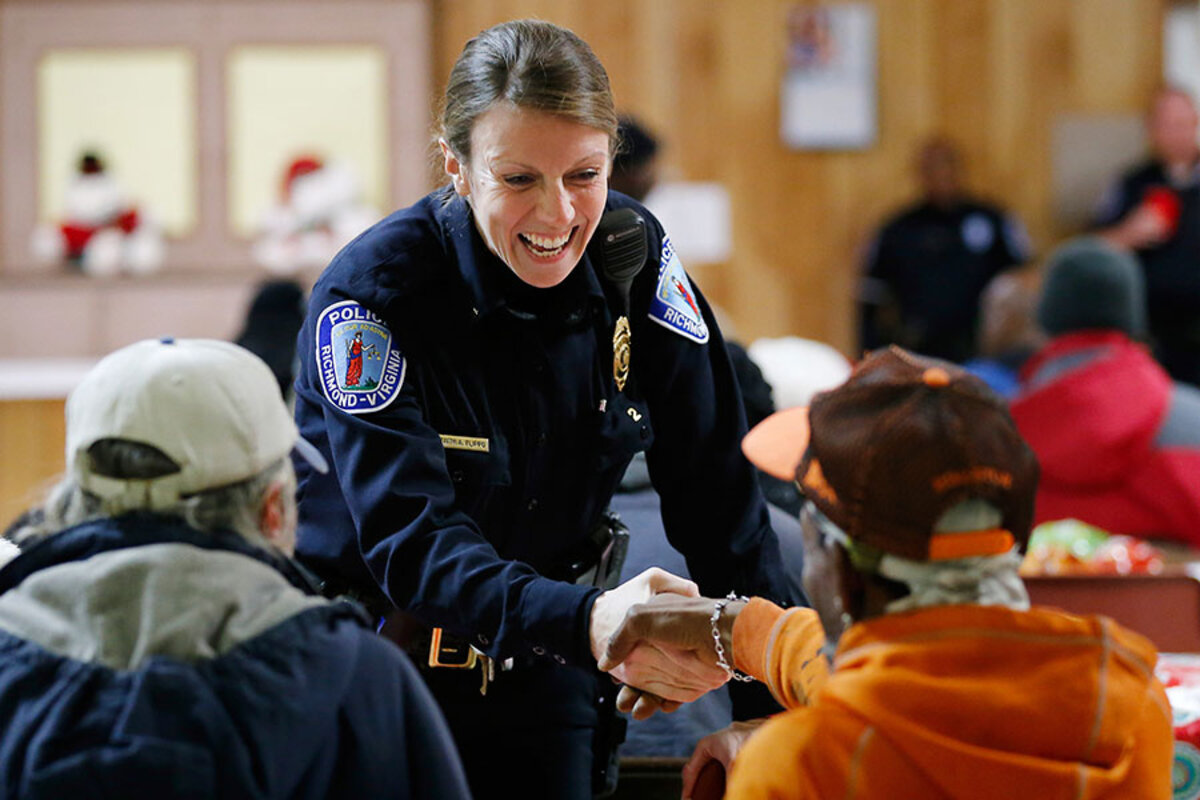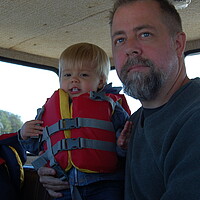Police see shifts in what it means to wear the badge
Loading...
On a sunny day last fall, Atlanta Police Officer Mike Costello had to decide whether a goat rescue mission would turn into a drug sting.
Gertie, it seemed, kept escaping from her yard. Neighbors, concerned for the goat, took the animal into custody – or, in the owner’s eyes, kidnapped her.
But it wasn’t until Mr. Costello arrived on the scene that the real complication arose: The owner admitted that he had illegally “just smoked a joint.”
Costello, the Atlanta Police Department’s officer of the year, kept his wits about him, solved the spat, and chose not to cart the pot-smoking goatherd into the precinct.
“I don’t care what the guy does in his own house, but that a goat can cause such a commotion in a community, well, maybe there’s something we, as a police department, can help with there,” he said of his intervention.
Sure, it was the kind of moment that most Americans don’t ever see: a well-trained officer using discretion and courtesy to turn a potentially tense situation into one where, in the end, there are smiles and a sense of resolution.
Yet there is something deeper in the simple exchange. Even at a time when cops say they feel under siege amid perceptions of anti-police bias, a study released this week underscores evolving attitudes among police officers. It suggests the nature of police work in America might be beginning to shift from the militarized force geared to the get-tough-on-crime 1990s to a sense of “policing by consent” amid historically low crime.
The Pew Research Center’s “Behind the Badge” survey of 8,000 police officers shows that while racial attitudes persist – especially in how events and suspicions are perceived – a solid majority of police officers are aligned with the general public on the root causes of discontent, including the need for more training, tougher discipline toward rogue cops, emphasis on de-escalation, decriminalization of recreational drugs, and broader societal focus on mental health.
“The situation on the ground is improving … in part because of the scrutiny policing has been getting,” says Jack Glaser, a social psychologist at University of California at Berkeley.
Finding a balance
That scrutiny has also created tension. Three of 4 sworn officers said declining relations with minority communities has made officers less willing to stop and question suspects and use force when they deem necessary.
“There’s a perception that police are less likely to do the marginal additional policing that suppresses crime – the getting out of your car at two in the morning and saying to a group of guys, ‘Hey, what are you doing here?’ ” Federal Bureau of Investigation Director James Comey said last year.
Two-thirds said they have been verbally abused by a member of the community during the past month. But 8 of 10 also say they have been thanked by a member of the community.
Gratitude toward police officers “is at the highest level we’ve seen it since 9/11,” says Bill Johnson, executive director of the National Association of Police Organizations.
Mr. Johnson says that trend reflects that “police departments in general are willing to accept and profit by constructive criticism,” but it also suggests that “the public don’t want a surrender of public safety on our streets.”
Instead, “they’re searching for a level of confidence that police are [treating all citizens] in an ethical and just manner.”
Finding that right balance has led to confusion at the beat level about what officers are really out there doing. A few years ago, a sign outside a Cleveland precinct that said "Forward Operating Base" seemed natural. Today, equating a tough American neighborhood with a war-torn Afghan village seems inappropriate, at least according to a Department of Justice report that cited the sign.
“From the officers' perspectives, most of what they're doing is patrolling and responding to calls for service,” says Professor Glaser.
What’s coming to the fore is “the perspective of people in the community, particularly blacks, where most of their contact with the police is unpleasant (being stopped, questioned, or searched). Even casual, non-enforcement contacts with police are likely unpleasant for minorities because they know they are regarded with greater suspicion.”
Can less be more?
That has spread the idea that sometimes less can be more in policing. For example, New York City has backed off its “stop and frisk” policy, which allowed officers to stop people based only on minimal suspicions. Crime has continued to drop even after the program was curtailed.
Indeed, the debate over militarized versus “consent”-style policing is helping police officers properly define what constitutes a good stop – meaning one which actually solves or prevents a crime.
“Police training needs to be better in terms of helping officers understand when it is or is not appropriate to stop and question someone,” says Delores Jones-Brown, a criminologist at John Jay College of Criminal Justice and author of “Policing and Minority Communities: Bridging the gap.”
There are signs that understanding could be growing. Nine of 10 officers say it’s at least somewhat important to understand the people and culture of their beats in order to actually be effective crime-fighters. Only 3 of 10 view their patrol areas as hostile territories, with the majority of cops believing that at least some of the residents of those neighborhoods share their values.
“In the long term, these [attitude shifts] will be reflected in improved public attitudes toward the police,” says Glaser, in an email. “But we shouldn’t expect this to be instantaneous. Just as police stereotypes of minorities as prone to crime and violence are hard to attenuate, so will public perceptions of police be.”





